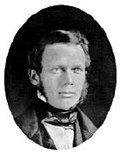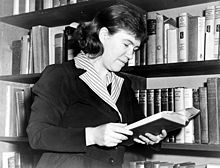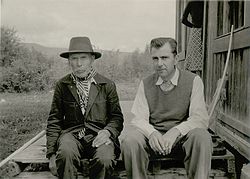2.3: Historic Cultural Anthropologists
- Page ID
- 5290

Lewis Henry Morgan
Lewis Henry Morgan was born on November 21, 1818, near Aurora, New York. He graduated from Union College in Schenectady in 1840 and became an attorney by profession. Later, he studied the Iroquois people of western New York and gathered extensive data about the Iroquois Confederation. He is best known for his work on kinship and social structure, his theories of social evolution, and his ethnography of the Iroquois. Kinship is the web of social relationships between individuals and groups that form an important part of the lives of most humans in most societies. Interested in what holds societies together, he proposed the concept that the earliest human domestic institution was the matrilineal clan, not the patriarchal family.[3]
His book “League of the Ho-dé-no-sau-nee, or Iroquois” (1851) is considered one of the earliest objective ethnographic works of native peoples. From the book, one of the most important pioneering achievements of the first order is the study of kinship systems. What he found was that the Seneca designate their kin in a manner different from that of the Western culture. Unlike Western culture, they merge collateral relatives, such as cousins, nieces, and aunts, into the direct line, like fathers, sisters, and daughters.

Edward Burnett Tylor
Sir Edward Burnett Tylor (1832-1917), was born in Camberwell, London, England in 1832. He graduated from Grove House High School but, never received a university degree due to the death of his parents. Following their death, Tylor started having symptoms of tuberculosis. He decided to leave England and travel to Central America in search for a warmer climate. This is where he first started his research on anthropology. He is considered one of the early proponents of cultural evolutionism in Anthropology. He had awards and achievements which were Elected a Fellow of the Royal Society in 1871, Honorary degree of Doctor of Civil Laws from the University of Oxford in 1875 and Knighted for his contributions in 1912.
His first book, aptly titled Anthropology (1881), is considered fairly modern in its cultural concepts and theories. In 1883, Tylor joined the University Museum at Oxford and became a professor of Anthropology from 1896 to 1909. Most of Tylor's work involved the primitive culture and the minds of the people, particularly animism. Animism is a philosophical, religious or spiritual idea that souls or spirits exist not only in humans and animals but also in plants, rocks and natural phenomena. His work has been the foundation of many universities' Anthropological major curriculum. Some of his later works include: Researches Into the Early History of Mankind (1865) and Anahuac (1861). His most important work, "Primitive Culture" (1871), which was partially influenced by Darwin’s theory of biological evolution. It developed the theory of an evolutionary, progressive relationship from primitive to modern cultures. It did this by defining "culture or civilization" as "that complex whole which includes knowledge, belief, art, moral, law, custom, and any other capabilities and habits acquired by man as a member of society". This definition encouraged the idea that even primtives possessed capabilities ad habits that merited respect. Primitive stereotypes were thus changed.[4] During his travels, he met a man named Henry Christy, who was also a Quaker interested in ethnology and archaeology, which influenced Tylor's interest in these areas.
Franz Boas

Franz Boas, known as the Father of American Anthropology, was born in Minden, Germany in 1858. He earned a Ph.D. in physics with a minor in geography at the University of Kiel in 1881 and later became a professor and founded the first department of anthropology in the United States at Columbia University.[5]
Boas is well known for his studies on the Native population in Northern Vancouver and British Colombia, Canada. Influenced by the writings of Charles Darwin, Boas developed the theory of cultural relativism; Cultural relativism is the interpretation of another culture using their own goals, values, and beliefs rather than our own to make sense of what people say and do, devoting much of his life’s work to discrediting the importance of racial distinction in the field. At a time when armchair anthropology and racial prejudices were rampant, Boas emphasized the importance of impartial data, the use of the scientific method in his research, and rejected the idea of Western civilization’s supposed “cultural superiority.” Boas gave modern anthropology its rigorous scientific methodology, patterned after the natural sciences. He originated the notion of "culture" as learned behaviors as well. His emphasis on research first, followed by generalizations, emphasized the creation of grand theories (which were only after tested through field work) Link: Boas. Boas was truly the first person to develop an ethnography which is a descriptive account of anthropological studies. A few of Boas’ students include anthropologists Alfred L. Kroeber, Margaret Mead, Jules Henry, and Ashley Montagu. Boas became Professor Emeritus in 1937, after serving over 40 years as Professor at Columbia University. He died in 1942.
Ruth Benedict

Ruth Benedict was an American anthropologist whose work was greatly influenced by her mentor and teacher Franz Boas, the father of American anthropology. She was born in New York City on June 5, 1887 and died September 17, 1949. She graduated from Vassar College in 1909 and entered graduate studies at Columbia University in 1919, studying under Franz Boas and receiving her PhD in 1923. The central idea of her book Patterns of Culture (1934), which was translated into fourteen different languages and used in universities for many years, is that each culture chooses from the “great arc of human personalities” but, only dominant traits emerge in people’s characters as well as the overall character of society. Ruth Benedict expressed the idea that ontogeny recapitulates phylogeny which holds that the growth or change of the individual is a reflection of the growth or change of the species. She desired to show that each culture had its own moral imperatives that could be understood only if one studied that culture as a whole. Benedict conducted fieldwork in New Mexico with the Native American Pueblo people and used data from Franz Boas and other colleagues like Margaret Mead to supplement her research.
Margaret Mead

Margaret Mead (1901-1979) was the oldest of five sisters. Mead was born on December 16, 1901 in Philadelphia, Pennsylvania. After graduating from Barnard College, she received her Ph.D. from Columbia University[3]. It was there where she met her greatest influences, the anthropologists Ruth Benedict and Franz Boas. She was married three times in her life, her first marriage with Luther Sheeleigh Cressman, an archaeologist. Her third and longest-lasting marriage (1936–1950) was to the British Anthropologist Gregory Bateson with whom she had a daughter, Mary Catherine Bateson, who would also become an anthropologist. Margaret Mead focused mainly on child-rearing and personality traits in Samoa, New Guinea, and Bali. It was here she was able to take a positivist method to her research. Mead was also popular to mass media as a speaker and writer of her work.
In the 1930’s Margaret Mead used a method called controlled comparison, or taking hypotheses to different cultural settings. Each setting would match up to a separate experiment. This allowed anthropologists, such as Mead, to study human life by participant-observation instead of an artificial lab setting. Mead used this method when she studied four different societies in an attempt to discover the range and causes of gender role. It is still used today. Margaret Mead was known for introducing radical proposals and being an activist. One of her most memorable stances on issues was her outspoken advocacy on birth control.From her findings, she was able to produce many ethnographic writings, such as Coming of Age in Samoa (1928) and Sex and Temperament in Three Primitive Societies (1935)[3].
Julian Steward

Julian Steward was born on January 31, 1902, in Washington D.C. Steward attended the University of California, Berkeley, and Cornell University, graduating with a B.Sc. in Zoology in 1925. He returned to Berkeley for graduate studies, earning his Ph.D. in Anthropology in 1929 with a thesis entitled The Ceremonial Buffoon of the American Indian, a Study of Ritualized Clowning and Role Reversals. Steward went on to establish an anthropology department at the University of Michigan, where he taught until 1930. The department later gained notoriety from the appointment and guidance of Leslie White, with whose model of "universal" cultural evolution Steward disagreed. Steward's career reached its apogee in 1946 when he took up the chair of the anthropology department at Columbia University - the center of anthropology in the United States. Steward quickly developed a coterie of students who would go on to have enormous influence in the history of anthropology, including Sidney Mintz, Eric Wolf, Roy Rappaport, Stanley Diamond, Robert Manners, Morton Fried, Robert F. Murphy, and influenced other scholars such as Marvin Harris. Many of these students participated in the Puerto Rico Project, yet another large-scale group research study that focused on modernization in Puerto Rico. Steward left Columbia for the University of Illinois at Urbana-Champaign, where he continued to teach until his retirement in 1968. There he undertook yet another large-scale study, a comparative analysis of modernization in eleven, third-world societies. The results of this research were published in three volumes entitled Contemporary Change in Traditional Societies. Steward died in 1972.
Steward is most remembered for his method and theory of cultural ecology. During the first three decades of the twentieth century, American anthropology was suspicious of generalizations and often unwilling to draw broader conclusions from the meticulously detailed monographs that anthropologists produced. Steward is notable for moving anthropology away from this more particularist approach and developing a more nomothetic, social-scientific direction. His theory of "multilinear" cultural evolution examined the way in which societies adapted to their environment. Steward's interest in the evolution of society also led him to examine processes of modernization. He was one of the first anthropologists to examine the way in which national and local levels of society were related to one another. He questioned the possibility of creating a social theory which encompassed the entire evolution of humanity, yet also argued that anthropologists are not limited to the description of specific, existing cultures. Steward believed it is possible to create theories analyzing typical, common culture, representative of specific eras or regions. In addition, he theorized there were decisive factors (technology and economics) and secondary factors (political systems, ideologies, religions, etc) that determine and influence the development of a given culture.
Ray Birdwhistell
Ray L. was born in Cincinnati, Ohio in 1918, he went on to get his Ph.D. in Anthropology at the University of Chicago in 1951. Later in life, he began to teach at the Universities of Toronto, Louisville, and Buffalo. He then became a professor at the University of Pennsylvania where he pursued his interest in nonverbal communication and kinesics. Birdwhistell found most of his studies through observing people interactions in films. His observations concluded that people use eye movement, facial expressions, and their chest to convey information. Birdwhistell was the founder of Kinesics, the study of the human environment as culturally patterned visual communication, he released two texts on Kinesics, Introduction to Kinesics, and the better known Kinesics in context. Birdwhistell was a mentor to renowned folklorist, ethnomusicologist Alan Lomax. More on Kinesics in the Communication and Language Chapter.
Marvin Harris
Marvin Harris (1927-2001), was born on August 18, 1927, in Brooklyn, New York. Harris joined the U.S. Army in World War II then attended Columbia University. After graduating, Harris became an assistant professor at Columbia University, his main focus of the study was ideological features of culture. Later Harris did fieldwork in Mozambique in 1957 and started focusing more on behavioral aspects. He is also well known for his explanation on Indian cultures ‘sacred cows’. Harris did most of his fieldwork in Brazil, Mozambique, India, and Ecuador.
Harris was an American Anthropologist known for his writing and influence on cultural materialism. Harris’ studies were mostly based on Latin America and Brazil. Harris used Karl Marx and Malthus’s information to help form his own opinions and ideas. Harris had over 16 books published. After Harris’ publication, The Rise of Anthropological Theory, the American Anthropological Association had lots of talk and criticism about his theory. Harris’ work has helped anthropologists learn and gain more information about his studies.
Napoleon Chagnon

Napoleon Chagnon was born in 1938 in Port Austin, Michigan. He is an American anthropologist who is best known for his ethnographic work with the Yanomamö tribe of the Amazon between Venezuela and Brazil. He was a major player in developing to the evolutionary theory of cultural anthropology. He first documented the Yanomami tribe as savages who treated him very poorly. As time progressed he gained greater insight of the workings of the tribe, and the nickname of Shaki, meaning "pesky bee".
Through his research of the Yanomamö people, Chagnon gained information about the genealogies of these people in order to find out who was married, who was related, and cooperation and settlement pattern history. Through this research he was a pioneer in the fields of sociobiology and human behavioral ecology. He also pioneered in visual anthropology, by creating documentaries about the Yanomamö people and their society. His works include: The Yanomamo Series, in collaboration with Tim Asch, including 22 separate films on the Yanomamo Culture, such as The Ax Fight (1975), Children's Magical Death (1974), Magical Death (1988), A Man Called Bee: A Study of the Yanomamo (1974), Yanomamo Of the Orinoco (1987). He has also written a few books on the Yanomamö culture: Yanomamö: The Fierce People (1968), Chagnon, N. (1974), written at New York, Studying the Yanomamö, Holt, Rinehart and Winston, Yanomamo - The Last Days Of Eden (1992).
Although much of his work was meant to document the growing of a culture, he has also been credited as a destroyer of the culture. According to Darkness in El Dorado, by Patrick Tierney, Chagnon aided the spreading of measles to the Yanomamo people. All claims by Tierney have been refuted, but it is a fact that due to exposure to other outside cultures, the people of this tribe were exposed to diseases that their bodies could not fight. Chagnon was not only known for his ethnography but he was also well known for criticism and controversy about his work and opinions.
Paul Farmer

Paul Farmer is a well recognized medical anthropologist and doctor. While working towards his graduate degree at Harvard University, he began working to provide health care to the poor populations. This initiated his lifelong focus on providing proper health treatment to poverty stricken populations around the world through nonprofit work and through an anthropological lens regarding the social change necessary to aid the countries. At Harvard, Farmer specialized in infectious disease and currently focuses on those that disproportionately affect the poor, such as tuberculosis. In 1987, Farmer helped put together a nonprofit called Partners in Health. To this day, the group treats 1,000 patients daily for free in the Haitian countryside as well as provides works to cure drug-resistant tuberculosis among prisoners in Siberia and in the slums of Lima and Peru. Farmer uses his anthropological knowledge and ethnographic analysis to create sustainable and practical health care services for those in need. He works to offset the negative effects in those societies caused by social and structural violence. Farmer is well known for the concept of "pragmatic solidarity", the idea of working to meet the needs of the victims while advocating for positive social change. Farmer has been awarded several honors; including the Conrad N. Hilton Humanitarian Prize, American Medical Association's International Physician Award, and the 2007 Austin College Leadership Award.


